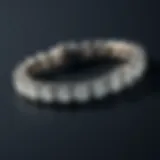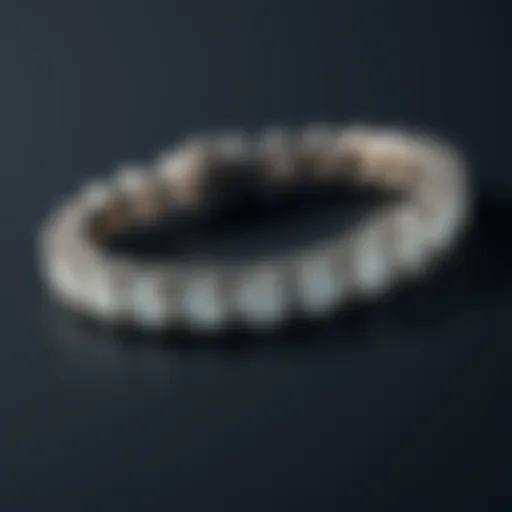Exploring Average Size Diamond Stud Earrings
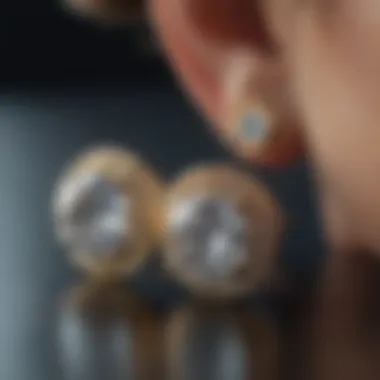

Intro
When it comes to jewelry, diamond stud earrings often find themselves at the pinnacle of elegance and allure. An essential piece in nearly every woman's collection, these earrings not only provide a subtle touch of sophistication but also reflect personal style and taste in a significant way. However, average size diamond stud earrings can offer much more than mere aesthetics. They embody a blend of cultural significance, personal expression, and intrinsic qualities worth exploring. This article navigates through the detailed dimensions of these exquisite gems, examining what makes average size diamond studs a preferred choice among enthusiasts and casual wearers alike.
Gemstone Overview
Definition and Characteristics
Diamonds, often referred to as the "king of gemstones", are not just beautiful; they are remarkable formations of carbon arranged in a crystal structure. Found deep within the Earth, under extreme pressure and temperature, they undergo a journey that can take billions of years to emerge as the sparkling gems we know today. The average size for diamond stud earrings generally hovers around 0.5 to 1 carat. However, what truly sets them apart are their exceptional properties, particularly brilliance and fire – reflections of light that captivate the beholder.
Classification of Gemstones
Gemstones can be classified into two primary categories: precious and semi-precious stones. While diamonds are firmly in the precious category, understanding why is essential. They are measured not only by their size but also by their color, cut, clarity, and carat weight, often known as the "Four Cs". Each of these metrics plays a critical role in defining the overall value and appeal of diamond earrings. Here's a quick overview of their classifications:
- Precious Stones: This category includes diamonds, rubies, sapphires, and emeralds. Their rarity, historical significance, and cultural importance give them a premium in the market.
- Semi-Precious Stones: These can be anything from aquamarine to garnets. While still valuable, they don’t carry the same weight of demand and prestige as precious stones.
Properties of Gemstones
Physical Properties
The allure of diamonds is not only skin deep. Their physical properties make them unique. With a hardness of 10 on the Mohs scale, diamonds are the hardest natural material known, making them resistant to scratching. In addition, their clarity and reflection capabilities lead to that coveted sparkle. Average size diamond studs typically possess a well-defined clarity grade that accentuates their on-ear appeal.
Chemical Properties
Chemically, diamonds consist solely of carbon atoms arranged in a crystal lattice. This unique structure contributes to their incredible durability and brilliance. Interestingly, the color of a diamond can vary widely, influenced by trace elements during formation. For instance, a diamond might appear yellow due to the presence of nitrogen or blue due to boron. Such variations not only contribute to their allure but also impact market value, especially for those looking to invest in more than just aesthetics.
"Diamond studs do not only enhance your look, but they also tell a story of their origins and uniqueness that mirrors our individual journeys."
The understanding of average size diamond stud earrings extends beyond mere size and shape. Their classification, properties both physical and chemical, all weave a narrative rich with potential meaning. As we continue to explore their dimensions, we will address personal preferences, cultural implications, and the importance of quality sourcing, giving you a broadened view of these timeless pieces.
Understanding Diamond Sizing
When it comes to diamond stud earrings, the understanding of sizing isn’t just about picking out something that looks pretty; it’s about delving deep into the nuances of what makes a diamond worthy of its sparkle. Knowing how diamond size works can significantly shape a buyer’s decisions, impacting aesthetics, personal style, and even emotional significance.
Grasping the mechanisms behind sizing helps potential customers align their choices with their preferences or needs. Not everyone is after the biggest rock; sometimes it’s about the balance of size with quality. Having a robust understanding of diamond sizing also aids in knowing how that size fits within the broader realm of jewelry fashion and individual expression.
Let’s get under the surface and unfold the intricacies that diamond sizing brings to the table.
The Basics of Carat Weight
Carat weight represents a diamond's size and significantly influences its price. One carat is equal to 200 milligrams, and while more carats can mean a larger stone, it isn’t the only factor to consider. For instance, two diamonds might have the same carat weight but look considerably different based on their cut and shape.
So, a one-carat diamond may not always be the ideal choice if it’s poorly cut. It's essential to remember that the perceived size can vary, even when the measurements are technically equivalent. This context adds layers to the meaning of "average size" in the diamond stud conversation.
Measuring Diamond Size
Diameter versus Carat
When measuring a diamond's size, typically, there are two crucial metrics: diameter and carat weight. The diameter, often measured in millimeters, is the physical width of the diamond, whereas carat weight tells how heavy the diamond is.
It’s like comparing apples and oranges; a one-carat diamond could have different diameters that ultimately impact how it appears in a setting. For instance, a round brilliant diamond may present a wider appearance at the same carat weight than a princess-cut diamond because of the specifics in their cut and shape. So, when evaluating options, a larger diameter can sometimes create a more substantial visual impact, even at a similar carat weight.
The Role of Cut in Size Perception
Cut plays a pivotal role in how we perceive a diamond's size. A well-cut diamond—one that reflects light optimally—can appear larger than its actual carat weight. Factors such as depth and table size also influence light return and, consequently, how the size is perceived.
This aspect makes cut a crucial factor in selecting diamonds, especially when considering average sizes. A diamond that sparkles and radiates light tricks our eyes into thinking it’s larger than it is. In a nutshell, a good cut is not just about aesthetics but also elevates the overall perception of size and value.
Differences in Shape and Their Impact
Different shapes come with different sizing perceptions. The traditional round cut holds a certain allure, while fancy shapes like oval, pear, or cushion offer their own charm and often present differently than their round counterparts.
Round versus Fancy Shapes
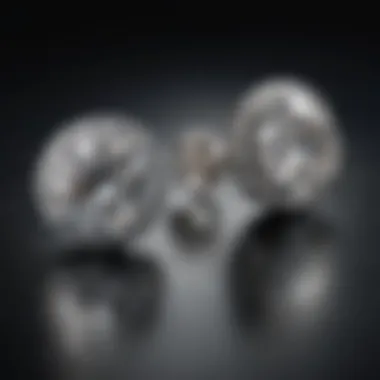

Round diamonds remain the classic choice; they can maximize light and create that sparkle factor that many desire. Yet, fancy shapes have been gaining momentum in popularity. For example, an oval or marquise diamond can look larger than its round equivalent, often due to their elongated shapes.
When one thinks about average size, incorporating these fancy shapes into the equation enriches the selection pool. What's beneficial here is that many buyers can find a unique look while still maintaining the desired visual impact without necessarily jumping several carats.
Understanding Proportions
Proportions also play a significant role in how a diamond appears. Understanding proportions means recognizing how the different facets of the diamond interact with each other. It’s not just about length and width but also the depth that can influence how the stone is perceived.
A diamond may appear smaller than its carat weight if it’s too deep or too shallow. When consumers grasp these concepts, they can better navigate their decisions, opting for what will best suit their style while also ensuring they’re getting a diamond that meets their expectations.
"Size is not just about how big your diamond is, but also how it complements your style, features, and overall preference. "
Average Sizes in Popular Culture
When discussing average size diamond stud earrings, one must acknowledge the intricate relationship between culture and the choices we make regarding jewelry. The societal standards and trends that dictate what is considered ‘average’ play a pivotal role in guiding consumer preferences and perceptions. This intersection of culture and personal choice not only shapes individual taste but also influences market trends.
Defining 'Average' in Context
Defining what constitutes an average size for diamond stud earrings can be slippery. Depending on various factors such as geographical location, socio-economic status, and even generational views, the average size can differ significantly. Typically, however, in North American markets, earrings that are around half a carat each are deemed to be in the average range. This particular size often strikes a balance, offering visible elegance without overwhelming the wearer. Additionally, this average is easily accessible for most budgets, making it a common choice among shoppers.
Trends in Choosing Diamond Studs
In recent years, the popularity of diamond studs has soared, influenced largely by cultural icons and the digital age. As consumers lean towards more informed decisions, tracking trends in diamond stud choices offers valuable insights into what drives purchases today.
Influence of Celebrity Choices
One cannot overlook the significant impact celebrities have on consumer behavior when it comes to jewelry. Public figures often illuminate what is current and stylish. For instance, celebrities like Meghan Markle have been spotted wearing simple yet striking diamond stud earrings, elevating their status as a must-have piece of jewelry. Their influence often pushes average consumers to seek similar silhouettes and styles.
Another aspect to consider is the weight that celebrity endorsements carry. When a well-known personality donning average-sized diamond studs is plastered across multiple media outlets, those earrings transform from a simple accessory into a cultural statement. They portray a sense of understated luxury, which resonates especially with those who aspire to elegance without extravagant excess.
Social Media's Role in Size Norms
Social media platforms have emerged as powerful arenas for defining and reshaping norms around diamond sizes. Instagram, for example, showcases a plethora of influencers flaunting their bling, igniting trends that ripple through audiences. Posts featuring average-sized diamond stud earrings can accumulate thousands of likes, often leading followers to emulate the same look. The stylish way these earrings are incorporated into everyday settings provides a relatable context for buyers, promoting the notion that bigger isn't always better.
The visual-driven nature of these platforms allows users to compare trends actively, creating a sense of community around similar tastes. However, this also leads to a homogenization of styles as influencers often promote specific brands or designs. The normalization of certain sizes can pressure individuals to conform to current trends rather than curating personal choices that genuinely reflect their style and budget.
"Trends may come and go, but the choices we make are often guided by those with influence. The average size diamond stud earrings embody this blend of tradition and modernity."
As we delve deeper into the conversation about average sizes, it becomes clear that the interplay between societal influences – from celebrity culture to social media norms – shapes the modern landscape of diamond stud earring choices. Such discussions lend depth to our understanding of personal style and help in appreciating the complexities behind what is now considered average in today’s world.
Significance of Size in Personal Style
When it comes to personal adornment, particularly in the realm of diamond stud earrings, size holds a multifaceted importance. This significance stretches beyond mere aesthetics; it plays a crucial role in how an individual expresses their individuality and aligns their jewelry choice with their overall style narrative. Understanding the nuances of size can enhance one's overall look, elevating straightforward outfits into statements of elegance.
Complementing Facial Features
Every face has unique proportions and characteristics that can either accentuate or diminish the allure of any adornment, especially with diamond stud earrings. For instance, larger studs can dominate a smaller face, while petite earrings might seem lost on someone with broader features. Therefore, selecting a size that harmonizes with one’s facial structure is an essential aspect in jewelry selection.
- Facial Shape Considerations: Knowing your face shape can immensely influence your choice. For round faces, larger, geometric designs can add balance. Conversely, softer, smaller studs may complement angular features better.
- Earring Position: The way earrings sit on the earlobe matters too; heavier earrings might pull down and cause discomfort or sagging, which can detract from the intended elegance.
Finding the right size is akin to choosing the right frame for a painting; it can make all the difference in how the entire piece is perceived.
Occasions and Appropriate Sizes
Diamonds, while timeless, are best showcased when thoughtfully chosen according to the occasion. For those navigating social functions or even everyday life, understanding the interplay between the context and earring size can lead to more profound confidence in one’s appearance.
Daily Wear versus Formal Events
Choosing earrings for daily wear often leans towards more understated sizes—ones that bring a subtle sparkle without stealing the show, allowing the wearer to blend into various environments effortlessly.
The key characteristic here is pragmatism: daily earrings should offer comfort and ease of wear while still feeling special enough for spontaneous moments.
On the flip side, formal events often invite a bolder approach. Larger earrings, while sometimes ostentatious, can transform an outfit from simple to stunning. They create focal points that draw the eye and can often convey a sense of sophistication or even glamour. In this context, size does not disappear into the background; rather, it provides a beacon of elegance amidst a sea of attire.
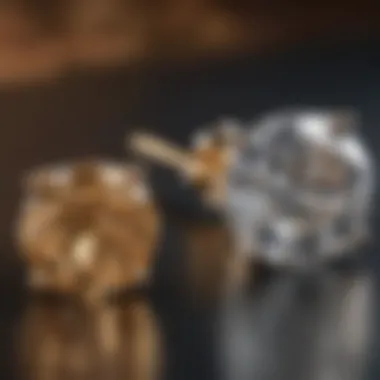

- Advantages of Daily Wear Choices: Everyday options typically prioritize comfort, versatility, and accessibility. They allow the individual to add a touch of elegance without overshadowing the ensemble they wear.
- Disadvantages of Overly Bold Choices: In contrast, garish or overly dramatic pieces can hinder a person's style instead of enhancing it. Striking that fine line is crucial to wearers who wish to maintain a sense of balance in their wardrobes.
Understanding Contextual Preferences
Every social setting comes with its own set of unspoken rules regarding appropriate size and style for earrings. What might be perfectly acceptable at a casual brunch could raise eyebrows at a business meeting. Thus, understanding these contextual preferences is key to successfully curating a jewelry collection that feels both expressive and fitting.
- Benefits of Recognizing Context: By tailoring earring selection to fit the nuances of each occasion, wearers can seamlessly glide through events feeling confident and aware of their styling choices.
- Considerations for Personal Style: This attentiveness fosters a deeper connection between how one feels in their jewelry and how it is perceived by others. Awareness of the social setting can empower the wearer and reinforce their personal style framework.
In the end, the role of size in personal style, particularly regarding diamond stud earrings, is about more than just glittering stones. It’s a careful dance of aesthetics, context, and self-expression that can define not just an outfit but a persona.
Quality Over Size
When it comes to diamond stud earrings, the adage "size matters" seems to reign supreme in the minds of many. However, as this article explores various facets of average-sized diamonds, it’s essential to pivot the discourse towards a more measured perspective: the quality of the diamond triumphs over its size. This assertion stems from the understanding that a smaller diamond of high quality can often outshine a larger one with mediocre characteristics.
From the clarity of a stone to the finesse of the cut, each quality component plays a pivotal role in how a diamond is perceived. A deeper focus on quality not only elevates the aesthetic appeal but also offers a greater investment value in the long run. Choosing a diamond is not merely a pursuit of size, but rather an orchestration of factors that harmonize to showcase elegance and personality.
The Four Cs: Cut, Clarity, Color, Carat
The Four Cs—Cut, Clarity, Color, and Carat weight—serve as the foundational quartet for assessing diamonds.
- Cut: This reflects how well the diamond has been shaped and polished. The quality of the cut affects how light interacts with the diamond, influencing its brilliance and sparkle. The better the cut, the more radiant the diamond will appear, regardless of size.
- Clarity: Clarity measures the presence of internal or external imperfections, known as inclusions and blemishes. A high-clarity diamond appears more transparent, allowing for the breathtaking beauty to shine through.
- Color: Diamonds come in a spectrum of colors, with colorless stone being the most valued. The whiter the diamond, the more sought after it is. Light yellow or brown tints can detract from the overall beauty and reduce the value.
- Carat: Often confused with size, carat actually refers to the weight of the diamond. Two diamonds of the same carat can differ significantly in size depending on their cutting, which leads us back to the importance of the other three Cs.
In summary, while the carat weight may be what first catches the eye, it's the interplay of the cut, clarity, and color that truly defines a diamond’s essence.
Evaluating Diamond Quality Relative to Size
Comparative Analysis Across Sizes
The notion of evaluating diamond quality in relation to size invites a fascinating discourse. A diamonds' value doesn't scale linearly with size; rather, it undergoes a complex evaluation based on its intrinsic properties. When comparing two stones, one must ponder not just the carat weight but also the accompanying attributes that govern how each diamond performs aesthetically. A well-cut half-carat diamond could outshine a poorly crafted one-carat diamond, which brings us to the crux of the analysis: a diamond's quality isn't simply written on its size tag.
- Key characteristic: A diamond’s brilliance. A small gem, cut to perfection, might glitter with much more intensity than a larger stone that lacks cut precision.
- Benefits: Investing in quality can lead to a diamond that retains its value over time and continues to dazzle through the years.
- Unique Features: Diamonds can possess unique characteristics, making them truly one-of-a-kind. This aspect often cultivates an emotional connection, something size alone cannot achieve.
Popular Myths Debunked
Delving into popular myths surrounding diamonds offers a wealth of insight into public perceptions. One prominent myth is that bigger is automatically better. This notion can skew a buyer's perspective, leading them down a path that overlooks the jewel's triumphant qualities.
- Key characteristic: Value misconceptions. The average buyer may equate larger diamonds with higher quality, which isn't always true.
- Benefits of understanding this myth: Awareness can lead to more informed purchases. Shoppers may often find joy in discovering smaller, unique diamonds that tell a personal story.
- Unique Feature: Some stunning pieces are further distinguished by their fascinating origin stories or unique characteristics that cannot be measured in carats alone. These diamonds often reflect the allure of their journey rather than their size, showcasing the art and craft behind every piece of jewelry.
In essence, dispelling myths provides clarity and allows for a better appreciation of the beauty eithir in a petite gem or grandiose stone. Choosing quality over simple measurements can reveal an entirely new dimension to the allure of diamond stud earrings.
"A good diamond isn't merely a statistic; it's a story waiting to shine."
This approach leads to a more nuanced understanding, ensuring that each diamond stud earring isn't just an accessory, but a cherished symbol of elegance.
Ethical Considerations
In the world of diamond jewelry, conversations about ethical sourcing have gained traction. Discussions surrounding diamond origins have shifted from mere preference to downright necessity. As consumers become more conscious of their purchases, the importance of ethical considerations cannot be overstated. Buying ethically sourced diamonds means investing in not just a piece of jewelry, but a commitment to support sustainable practices in the diamond industry.
Diamonds have a complex history, with some associated to conflict zones where human rights violations are rampant. Understanding the ethical implications of diamond sourcing is key, as many buyers now seek to avoid diamonds that fuel violence or exploitation. The presence of certifications, like the Kimberley Process, aims to ensure that diamonds are conflict-free, yet nuances exist. Although certificates can serve as a guide, consumers must remain vigilant, as not all diamonds labeled as conflict-free actually are.
Moreover, supporting ethical sourcing practices promotes better labor standards and encourages fair treatment of workers in the mining and production processes. In essence, choosing ethically sourced diamonds indirectly uplifts communities that rely on this industry for their livelihoods.
Understanding Ethically Sourced Diamonds
Ethically sourced diamonds represent a response to a growing demand for transparency in the jewelry market. When a consumer chooses a diamond that is ethically sourced, they are essentially insisting on a supply chain that respects human rights. This spans from the mining process to the retail sales, encompassing safe working conditions, reasonable pay, and environmental stewardship.
In recent years, several companies have emerged that prioritize ethical sourcing. This shift has challenged traditional patterns and fueled innovation in how diamonds are mined and marketed. Brands that adhere to ethical practices often provide detailed information about the sources of their diamonds, allowing consumers to trace their purchase back to its origin. This empowerment gives buyers confidence in their decisions, knowing they are supporting responsible practices.
Moreover, ethically sourced diamonds often come in various forms, such as recycled diamonds or those certified by independent organizations. Many buyers have found satisfaction in knowing that their diamond not only represents beauty but also aligns with their values.
Lab-Created vs. Natural Diamonds
The rise of lab-created diamonds presents a fascinating dimension in the ethical conversation. These diamonds, grown in controlled environments, often come with fewer environmental and social repercussions compared to their mined counterparts. This section explores the benefits and considerations of choosing lab-created versus natural diamonds.
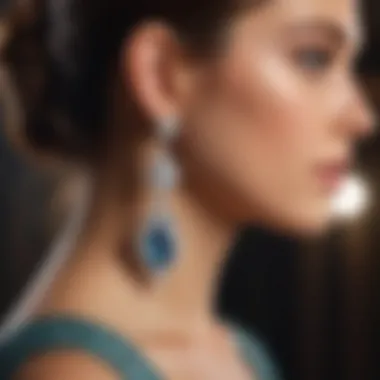

Environmental Impacts
When considering the environmental impacts of diamond sourcing, it becomes clear that lab-created diamonds often offer a lesser ecological footprint. Natural diamond mining can foreground significant land disruption, resource depletion, and pollution. In stark contrast, lab-grown diamonds use substantially less water and energy, making them an appealing choice for the environmentally conscious buyer.
The essential aspect of this environmental benefit rests not only in the reduced waste but also in the potential of lab-created diamonds to be produced with renewable energy sources, further minimizing their environmental impact. As a result, many consumers see lab-created diamonds as a more sustainable option without sacrificing quality or aesthetics.
Cultural Perceptions
Cultural perceptions of diamonds play an intriguing role in the discourse around their ethical implications. In many cultures, natural diamonds are revered as symbols of status, love, and commitment. Their allure often overshadows considerations regarding their sourcing.
As consumers today become increasingly educated about ethical sourcing, there is a burgeoning acceptance of lab-created diamonds. Some view them as equal to natural stones, while others struggle with the notion that a diamond without a 'natural origin' may not carry the same sentimental value.
The unique feature of cultural perception lies in its dynamic nature as societal values evolve. As conversations about sustainability and ethics grow, so too does an appreciation for lab-created alternatives. This paradigm shift suggests that in the near future, the notion of what constitutes a meaningful diamond may truly expand, allowing for a broader acceptance of both natural and lab-created diamonds alike.
Maintaining Diamond Elegance
When it comes to diamond stud earrings, the allure often lies in their understated elegance. However, to sustain that charm over time, it's vital to focus on maintaining their beauty. This section underscores the importance of care and proper exposure for diamond studs, providing readers with actionable insights into both cleaning methods and storage solutions. By recognizing these aspects, one can ensure that their jewelry remains not only visually appealing but also holds its value over the years.
Cleaning and Care Tips for Diamond Studs
Maintaining the luster of diamond studs is not just about the occasional wipe. Frequent cleaning is essential to remove dust, oils from skin, and other residues that accumulate over time. Here are some reliable methods for keeping those sparkling gems shiny:
- Gentle Soap Solution: Mix a few drops of mild dish soap with warm water. Soak the studs for a couple of minutes and use a soft brush to scrub gently. Rinse thoroughly under running water. This method is safe for both diamond and the prongs that hold them in place.
- Ultrasonic Cleaner: For deeper cleaning, an ultrasonic jewelry cleaner can provide impressive results. It uses sound waves to agitate a fluid to clean the jewelry. While it's effective, users must verify that their diamond studs are securely set and suited for such cleaning.
Also, avoid exposing diamonds to harsh chemicals found in some cleaning products, as they can dull the stone’s brilliance and damage the setting. Proper care not only enhances the visual appeal but also prolongs the lifespan of the jewelry, making it a crucial aspect for any diamond owner.
Storage Recommendations to Preserve Quality
Proper storage of diamond studs is key to avoiding scratches and keeping them in pristine condition. Here are some tips focused on ensuring the longevity of these precious items:
Avoiding Damage
When talking about avoiding damage, the primary concern is to prevent contact with other jewelry or hard surfaces. One of the effective strategies is to store diamond studs in a soft-lined jewelry box or a dedicated compartment within a jewelry organizer. This protects them from movement that could cause scratching or dulling.
- Key Characteristic: The main goal of this method is to keep your earrings away from potential hazards. This practice not only preserves the diamonds but also helps maintain the integrity of the settings.
- Unique Feature: One unique feature of storing earrings securely is the ability to position them so that they do not tangle with other pieces. This organized approach gives added peace of mind as one doesn't have to worry about the earrings merging with other jewelry items that might damage them.
Overall, emphasizing the importance of avoiding damage is a beneficial choice; it bolsters the longevity of your investment, saving potential replacement costs later down the line.
Organization Techniques
An organized approach to storing diamond studs can significantly enhance care efforts. Using a compartmentalized jewelry organizer or small cases with soft lining can work wonders not just for your diamond studs, but across your jewelry collection.
- Key Characteristic: This allows for easy identification and access, ensuring the wearer can stay organized and ready to wear them without digging through a jumble of jewelry.
- Unique Feature: One noteworthy aspect of adopting organization techniques is the capacity to categorize pieces by occasion or style. This helps individuals maintain their personal aesthetic while also protecting their valuables.
In summary, these organization tips hold substantial advantages; they facilitate ease of access while simultaneously promoting proper care practices. By taking these simple steps, wearers can elevate the maintenance of their average size diamond stud earrings to a new standard, ensuring they truly shine for years to come.
The End: The Lasting Appeal of Diamond Studs
When all is said and done, diamond stud earrings hold a unique charm that transcends fleeting trends and fads. Their allure lies in a delicate blend of simplicity and sophistication, making them a staple in many jewelry collections. The nuances of size and quality discussed throughout this article reveal why these gems deserve a cherished place in one’s accessories.
Finding Balance Between Size and Quality
In the world of jewelry, bigger is not always better. The quest for the perfect diamond stud often leads individuals to grapple with the relationship between size and quality. It’s tempting to gravitate toward a larger carat weight because it tends to catch the eye more easily. However, there are compelling arguments for prioritizing quality over mere dimensions.
Consider the different aspects of the Four Cs—cut, clarity, color, and carat—as essential elements that paint the bigger picture of a diamond’s value. A well-cut diamond, even if smaller, can outshine a poorly cut, larger one. This leads to the idea that a perfect quarter-carat stone can, in certain lights, appear more radiant than a half-carat diamond with noticeable inclusions.
"It's not just about the size of the rock, but how beautifully it is set in your life."
When selecting diamond studs, it sometimes pays off more to invest in a stone that radiates brilliance and possesses fewer blemishes rather than one that is oversized but lacks luster. Achieving a balance that caters to personal taste is fundamental, as well. Some prefer the understated elegance of smaller stones, while others might feel empowered by larger pieces. Knowing your preferences and investing wisely in quality can create a lasting impression.
Encouraging Informed Choices
Arming oneself with knowledge is vital. With the myriad of choices available, making informed decisions can truly enhance one’s jewelry collection. It’s essential to understand not just the superficial elements of a diamond but also the many factors that contribute to its true value.
Start by researching credible sources to gain insights into the ethical considerations around diamond sourcing, as discussed in earlier sections. Understanding the nuances of lab-grown versus natural diamonds is increasingly important in today’s market, as consumer preferences shift toward more sustainable options.
Moreover, engagement with community platforms and forums like Reddit or Facebook groups can provide new viewpoints. These spaces often foster discussions that broaden understanding and expose buyers to different perspectives.
In summary, harnessing the power of knowledge can lend clarity to the complex world of diamond shopping. This ensures that choices made today provide not just immediate satisfaction but also long-term value and significance. By choosing wisely, individuals can enjoy their diamond stud earrings for years to come, allowing them to shine bright in every setting.
